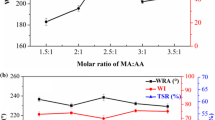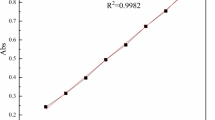Abstract
Low-molecular-weight copolymers of maleic acid and acrylic acid (P(MA–AA)), itaconic acid and acrylic acid (P(IA–AA)), and trans-aconitic acid and acrylic acid (P(TAA–AA)) were prepared and employed as the crosslinking agents for modification of cotton fabrics. The ester crosslinking effect of cellulose by P(MA–AA), P(IA–AA), and P(TAA–AA) was evaluated and compared with that by the most investigated polycarboxylic acids (PCAs), citric acid (CA) and 1,2,3,4-butanetetracarboxylic acid (BTCA). In detail, the Arrhenius activation energy (Ea) of esterification crosslinking reaction of cellulose with different PCAs was obtained by an acid–base titration method. The data displayed the order of Ea for different PCAs as P(TAA–AA) < P(MA–AA) < P(IA–AA) < BTCA < CA, therefore, P(TAA–AA) indicates the highest reactivity with cellulose. The percentage of carboxylic groups in PCAs esterifying with hydroxyl groups on cellulose and the wrinkle recovery angle of fabrics treated in similar conditions were measured to examine the order of Ea. Evidence proved that P(TAA–AA) showed the highest percentage of carboxylic groups participating in esterification with cellulose in the conditions of 180 °C × 2 min, which corresponds to the lowest Ea of P(TAA–AA). Besides, the distribution of PCA molecules inside cellulose fibers was evaluated by Confocal Raman microscopy. Raman depth mapping images of PCA-treated fibers provide an insight into the diffusion behavior of crosslinking agents in cellulose.








Similar content being viewed by others
References
Cai Z, Ji B, Yan K, Zhu Q (2019) Investigation on reaction sequence and group site of citric acid with cellulose characterized by FTIR in combination with two-dimensional correlation spectroscopy. Polymers 11:1–13
Dai Y, Xu H, Zhong Y, Zhang L, Sui X, Feng X, Wang B, Mao Z (2020a) Study on the effect of different dyeing systems on the interaction of multi-component reactive dyes by Raman spectroscopy. Color Technol 00:1–10
Dai Y, Yang B, Ding Y, Xu H, Wang B, Zhang L, Chen Z, Sui X, Feng X, Zhong Y, Mao Z (2020b) Real-time monitoring of multicomponent reactive dye adsorption on cotton fabrics by Raman spectroscopy. Spectrochim Acta A Mol Biomol Spectrosc 230:118051
Dai Y, Zhou P, Xu H, Zhong Y, Wang B, Zhang L, Sui X, Feng X, Mao Z (2021) Confocal Raman depth imaging tracking on the diffusion process of single and two-component reactive dyes in a single viscose fiber. Dyes Pigments 188:109160
Gao H (2004) Organic chemistry. Higher Education Press, Beijing
Harifi T, Montazer M (2012) Past, present and future prospects of cotton cross-linking: new insight into nano particles. Carbohydr Polym 88:1125–1140
Hu H, Dong X, Tang W, Yao J, He J (2018) Effects of molecular structures of poly-carboxylic acids on crosslinking reaction. Dye Finis 01:0001–0005
Ji B, Yan K, Sun G (2016) Investigation on functional properties of 1,2,3,4-butanetetracarboxylic acid cross-linked fabrics impacted by molecular structures and chemical affinity of catalysts. Ind Eng Chem Res 55:5216–5222
Liang T, Yan K, Zhao T, Ji B (2020) Synthesis of a low-molecular-weight copolymer by maleic acid and acrylic acid and its application for the functional modification of cellulose. Cellulose 27:5665–5675
Liang T, Yan K, Zhao T, Liu Y, Ji B (2021a) High strength retention of cellulose fibers crosslinking with synthesized low-molecular-weight copolymers of itaconic acid and acrylic acid. Cellulose 28:1167–1178
Liang T, Yan K, Zhao T, Ji B (2021b) Preparation of multiple-reactive-site and flexible crosslinking agent with transaconitic acid and acrylic acid and its application for three-dimensional crosslinking of cellulose. Text Res J. https://journals.sagepub.com/doi/10.1177/00405175211067823
Luo X, Shao D, Xu C, Wang Q, Gao W (2019) An eco-friendly way to whiten yellowish anti-wrinkle cotton fabrics using TBCC-activated peroxide low-temperature post-bleaching. Cellulose 26:3575–3588
Luo X, Shao D, Xu C, Wang Q, Gao W (2020) Whitening citric acid treated cotton fabrics by a TBCC-activated peroxide post-bleaching. Cellulose 27:5367–5376
Qi H, Zhao C, Qing F, Yan K, Sun G (2016) Antiwrinkle finishing of cotton fabrics with 5-(carbonyloxysuccinic)-benzene-1,2,4-tricarboxylic acid: comparison with other acids. Ind Eng Chem Res 55:11850–11856
Schramm C (2020) High temperature ATR-FTIR characterization of the interaction of polycarboxylic acids and organotrialkoxysilanes with cellulosic material. Spectrochim Acta A Mol Biomol Spectrosc 243:118815
Schramm C, Rinderer B, Bobleter O (1997) Kinetic data for the crosslinking reaction of polycarboxylic acids with cellulose. J Soc Dyers Colour 113(12):346–349
Schramm C, Rinderer B (1999a) Influence of additives on the formation of unsaturated PCAs produced during durable-press curing with citric acid. J Soc Dyers Colour 115:306–311
Schramm C, Rinderer B (1999b) Optimizing citric acid DP finishing to minimize fabric yellowing. Text Chem Color 31:23–27
Yan K (2009) Dyeing and finishing process and principle, vol 1. China Textile & Apparel Press, Hong Kong
Yang CQ (1991) FT-IR spectroscopy study of the ester crosslinking mechanism of cotton cellulose. Text Res J 61:433–440
Yang CQ, Bakshi GD (1996) Quantitative analysis of the nonformaldehyde durable press finish on cotton fabric: acid-base titration and infrared spectroscopy. Text Res J 66(6):377–384
Yang CQ, Wang X (1996) Formation of cyclic anhydride intermediates and esterification of cotton cellulose by multifunctional carboxylic acids: an infrared spectroscopy study. Text Res J 66:595–603
Yang CQ, Wang D (2000) Evaluating ester crosslinking of cotton fabric by a polycarboxylic acid using acid-base titration. Text Res J 77(7):615–620
Yang CQ, Wang X, Kang I (1997) Ester crosslinking of cotton fabric by polymeric carboxylic acids and citric acid. Text Res J 67:334–342
Yang B, Dai Y, Zhong Y, Zhang L, Xu H, Wang B, Sui X, Feng X, Chen Z, Mao Z (2020) A study of the diffusion behaviour of reactive dyes in cellulose fibres using confocal Raman microscopy. Color Technol 136:503–511
Zhao M, Zhou X (2005) Kinetics of esterification reaction of cotton fabric polymerization-crosslinking system. Proc Nation Symp Finish Print Dye 6:9–12
Acknowledgments
This research was funded by the National Natural Science Foundation of China (51803025), the Fundamental Research Funds for the Central Universities (2232020D-21), the State Key Laboratory of Bio-Fibers and Eco-Textiles (KF2020213), and the State Key Laboratory of New Textile Materials and Advanced Processing Technologies (FZ2020010).
Funding
The authors have not disclosed any funding.
Author information
Authors and Affiliations
Corresponding author
Ethics declarations
Conflict of interest
The authors declare that they have no conflict of interest.
Additional information
Publisher's Note
Springer Nature remains neutral with regard to jurisdictional claims in published maps and institutional affiliations.
Supplementary Information
Below is the link to the electronic supplementary material.
Rights and permissions
About this article
Cite this article
Liang, T., Yan, K., Zhao, T. et al. Evaluation of crosslinking effect of different polycarboxylic acids with cellulose by acid–base titration and anti-wrinkle performance. Cellulose 29, 4229–4241 (2022). https://doi.org/10.1007/s10570-022-04525-6
Received:
Accepted:
Published:
Issue Date:
DOI: https://doi.org/10.1007/s10570-022-04525-6




